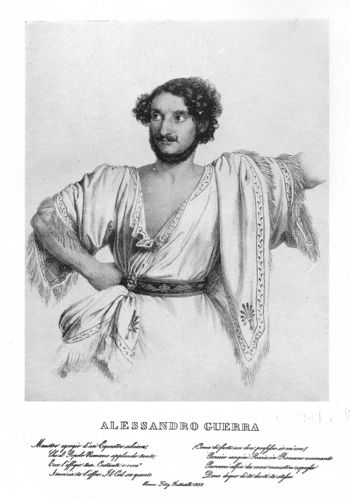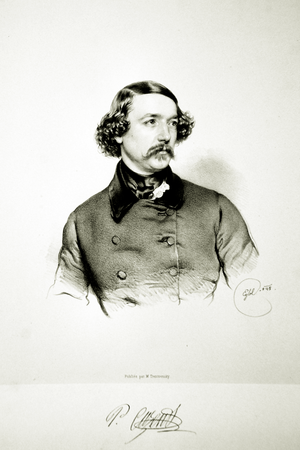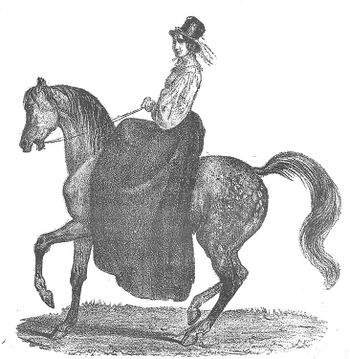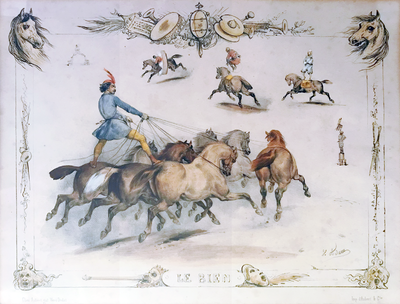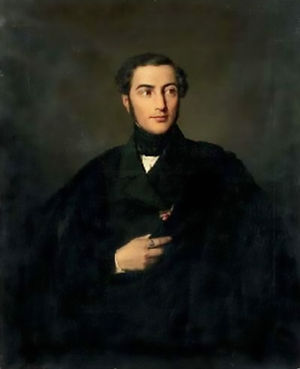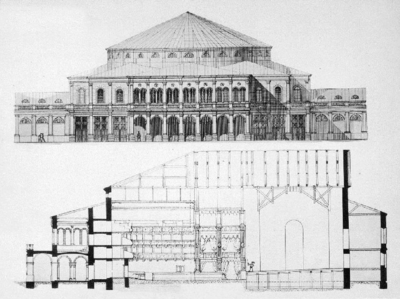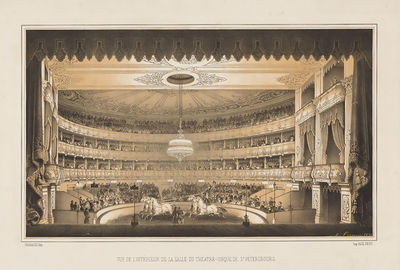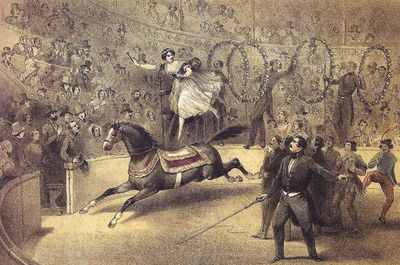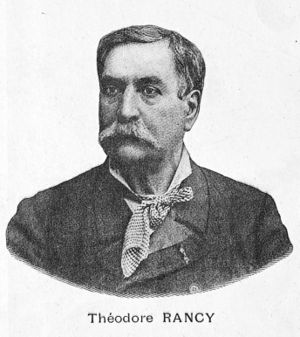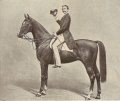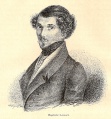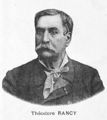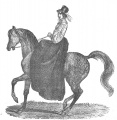Russia's First National Circus
From Circopedia
By Dominique Jando
On November 22, 1845, the Italian equestrian Alessandro Guerra and his troupe gave their first performance in the circus they had just built on the old Place des Manèges—the "merry-go-round square", today’s Theatre Square—in St. Petersburg, in the shadow of the stately Kamenny Theatre (the "stone theatre"). The Kamennyi was also known as the Bolshoi Theatre (the "grand" theatre), and like its homonym in Moscow, it housed the Imperial Ballet and Opera companies. For a long time, the vast Place des Manèges had welcomed visiting fairs and their merry-go-rounds, but the presence of the theater had since redeemed the square's prestige, and Guerra found himself in ideal surroundings.
Guerra’s Cirque Olympique
Born in Rimini, Italy, Guerra (1782-1862) had started his career at Vienna's Circus Gymnasticus, under the management of the Latvian equestrian Christoph de Bach, whose daughter, Adelhaid (Adelaïde), Alessandro had seduced and married. In 1826, he created his own company, which toured extensively the German and Italian states and the Austrian Empire under the name Circo Romano ("Roman Circus"). After the death of his father-in-law, Guerra engaged into a bitter rivalry with de Bach's widow, the beautiful Laura de Bach, before deciding to visit Russia, starting with its capital, Saint Petersburg. He had renamed his company recently, choosing the name (fashionable at the time) of Cirque Olympique, which had a French flavor, perfectly suitable for that mostly French-speaking city (Russian was then reserved for the lower classes!). Guerra, who was now 63, had been a remarkable trickAny specific exercise in a circus act.-rider in his youth, famous for his aggressive manner in the ring (which he also displayed in private life), which got him a nickname: Il Furioso.
The circus that Guerra built in St. Petersburg was a large, rectangular wooden building that looked a little like a hangar, but with a Grecian-style pediment adorned with equestrian scenes, and, above the public entrance, a little portico supported by six pillars. It was not very luxurious, but it was comfortable and well heated (an important detail in St. Petersburg, which the press duly reported) and was well lighted (another aspect vital to the citizens of St. Petersburg, berated as they were by endless winter nights). The stables housed fifty horses, and Guerra also built a coffeehouse adjacent to the circus itself.The richness of its costumes (in the Parisian fashion), the talent of its equestrians and, no less importantly, the beauty of its equestriennes guaranteed Guerra's enterprise an immediate success. Furthermore, his company, forty-strong, was particularly brilliant. It included Giuseppe Chiarini, then twenty-two, who would create his own company ten years later and embark into amazing tours around the world; Chiarini, along with Joseph Verdier, performed equestrian scenes in the manner of Andrew Ducrow. There was also the very talented and celebrated clown acrobat Ludovico (Louis) Viool, who was not unknown to St. Petersburg since he had already been there with the Tourniaire Company in 1837. Viool was on his way to become an important figure of the Russian circus.
Rodolfo Guerra, Alessandro's brother, played opera arias on the flute while standing on the back of a galloping horse. Finally, the great German high-schoolA display of equestrian dressage by a rider mounting a horse and leading it into classic moves and steps. (From the French: Haute école) rider, Julius Walter Hager, rounded this attractive group. Yet the male Russian aristocracy came principally to see the Circus' beautiful Amazons, who were in large supply in Guerra’s company: First, the panneau(French) A flat, padded saddle used by ballerinas on horseback. ballerinas—Mesdemoiselles Slapashinskaya; Louise Letard, who danced the zabadauda on her trotting horse; Josefina Guerra, who excelled at jumping over ribbons; and Lezenskaya, who added trickAny specific exercise in a circus act. riding to her exhibition. Then, there was the exquisite high-schoolA display of equestrian dressage by a rider mounting a horse and leading it into classic moves and steps. (From the French: Haute école) rider Ellen Kremzow, a favorite of the European equestrian set, who later married the Austrian Count Mensdorff-Pouilly, and was the crown jewel of this bouquet of pretty equestriennes. Maria Leb, Mathilde Baviera, Rosa Nellie, Marietta Orsanigo, and Angelika Hager completed the list.
Beside the libidinous dreams and amorous adventures that have always lingered in the wake of the Romantic era's equestriennes, Guerra offered something much more significant to the aristocrats and officers who patronized his circus: There, they were exposed for the first time to the subtleties of High School dressage, until then little known in Russia, and which were not only gracefully demonstrated to them by the likes of Ellen Kremsow, but also taught by Guerra himself and his old accomplice, Julius Hager.
As a result, Guerra developed a patronage of regulars who met in the morning and afternoon in his stables and around his manège, and at the circus’s coffeehouse. Rich and sometimes prone to startling liberality (as only aristocrats of Imperial Russia could be) they lavished Guerra—and his equestriennes—with their uninhibited largess.
Thus everything was well in the best of possible worlds. Or so was it until the rumor of the imminent arrival of another equestrian company spread over the gilded halls of St. Petersburg. To his consternation, Guerra discovered that it was the company that reigned supreme all over Europe, the Cirque de Paris of Paul Cuzent, Jean Lejars and Baptiste Loisset.
The Cuzent-Lejarses’ Cirque de Paris
An equestrian family of considerable talent, the Cuzents (Paul and his sisters, Antoinette, Armantine and Pauline) joined the company of Paris' Cirque Olympique, on the Boulevard du Temple, when Louis Dejean took over the Franconis' circus in 1835. Paul Cuzent (1812-1856) was then twenty-three, and his sisters Antoinette—who was married to Jean Lejars—and Armantine were already famous for their work on the panneau(French) A flat, padded saddle used by ballerinas on horseback. in an equestrian act they performed as Les Sœurs Jolibois, using their father’s stage name.
Pauline, on the other hand, was afflicted with a slight limp that prevented her from following into her sisters’ footsteps. Her brother initially relegated her to the role of musician, and then sent her to a theater company. But Pauline didn't see it that way: She took riding lessons with the "god" of High School dressage, François Baucher, and eventually became the rival of the most celebrated equestrienneA female equestrian, or horse trainer, horse presenter, or acrobat on horseback. of her time, Caroline Loyo.Armantine was married to the German equestrian Karl Berg, and the ravishing Antoinette to Jean Lejars, another equestrian in Dejean's company, who had won her heart during her first season at the Cirque Olympique. The charms of the "beautiful Madame Lejars," as Antoinette would become known, didn't leave anyone indifferent; the sculptor Pradier immortalized her as a bare-breasted Amazon in two versions of the same equestrian sculpture—one that adorned the pediment of the Cirque des Champs-Elysées until its demolition at the turn of the twentieth century, the other which can still be seen framing the façade of Paris's Cirque d'Hiver.
The Cuzents were the trump cards of Dejean's company; therefore the Parisian director was not particularly thrilled when Paul and his brother-in-law, Jean Lejars, announced their intention of creating their own company with the celebrated equestrian and director Baptiste Loisset. Dejean tried to sue them, but without effect, and the Cirque de Paris, as the new troupe was named, had a triumphant debut in Prague in 1844—and acquired instantly a reputation unparalleled in Europe.
Baptiste Loisset (1797-1863), a former pupil of Jacques Tourniaire, Christoph de Bach and Laurent Franconi, had created his own company in 1824. He was educated, flawlessly elegant, and had the reputation of composing his shows with infinite care and excellent taste. François Loisset (1826-1878), his son, who had worked with his father for many years, would soon succeed him at the helm of the company. Baptiste brought a solid experience to the triumvirate, and was probably the catalyst that triggered the creation of the new company. Baptiste Loisset's influence on Cuzent's later productions is manifest.
As for Paul Cuzent, he had become, since his debut with Dejean, one of Europe's premier horsemen. He had created the equestrian display known as "Roman Games," and performed La Poste Royale (an avatar of Andrew Ducrow’s The CourierAn equestrian presentation created by Andrew Ducrow in 1827 as ''The Courier of St. Petersburg'', in which a rider stands on two galloping horses, one foot on each, and allows other horses to pass between his mounts, catching their reins as they pass, eventually holding the reins a group of galloping horses in front of him. (Also known in French as ''La Poste''.)), which he presented with six horses. A consummate circus man, he was a good acrobat, an excellent director, and an able musician; he composed most of the tunes that accompanied his family's acts, and sometimes conducted the orchestra himself. (He even composed a one-act opera, L'Habit de Noce.) Cuzent was a leader and, obviously, the soul of the company. His sole presence in the ring, like that of his sisters Pauline and Antoinette, was enough to ensure the company's success.
The Cirque de Paris in St. Petersburg
In the fall of 1846, the Cirque de Paris arrived in St. Petersburg. The Cuzent-Lejarses built a wooden circus near the Alexandrinsky Theatre, a few yards from the Perspective Newsky, which they opened on October 8. The press noted that it was well heated and lighted (which, as we saw, was imperative) but that its narrowness rendered it uncomfortable, especially compared to Guerra's "vast" (in contrast) Cirque Olympique. Yet the comparison was not entirely to Guerra's advantage: the Cirque de Paris, it was said, gave a sensation of luxury, with its carpeted corridors, its warm colors, its fragrance burners which perfumed the house, and the flamboyant uniforms of its barrière(French) The line of uniformed artists and assistants who, in the old equestrian circus, stood at attention at the ring entrance to assist their fellow performers if needed. When seen today, the Barrière is usually made of the Ring Crew. .Word was in St. Petersburg that, compared to his rival, Guerra's circus looked like a gymnasium, whereas the Cirque de Paris was a parlor. Guerra's supporters stressed that the Cirque de Paris did not have as many equestriennes as the Cirque Olympique, and that they were not as beautiful—with the notable exceptions, perhaps, of Pauline Cuzent, who had just celebrated her sweet sixteen, and whose "distinction was so perfect that the grandest ladies of the aristocracy asked her to teach them," and, of course, of the beautiful Madame Lejars.
Nonetheless the public soon realized that Mrs. Lejars and the Cuzent sisters were doing tricks that only men could achieve at Guerra's. And there was Paul Cuzent, at his peak at thirty-three, athletic and handsome with his dark looks and bellicose moustache, and his incomparable talent. If that was not enough for Guerra's regulars to swing toward the Cirque de Paris, they could also laugh at the antics of their favorite clownGeneric term for all clowns and augustes. '''Specific:''' In Europe, the elegant, whiteface character who plays the role of the straight man to the Auguste in a clown team., Louis Viool, who, sensing the change of wind, quickly deserted Guerra and joined the competition. At the Cirque de Paris, Guerra’s regulars could also cheer on the juggler on horseback Jean Chancelet, the acrobatic feats of the brothers René and Jacques Dauvergne, and the young equestrian Jules Lejars—who was a mere four-year-old.
Guerra, however, didn't stay hands-tied. One of his sponsors, the Count Orlov, had presented him with 200,000 rubles, no less, to fight the invader, and Guerra used that money to beef-up his company. He called for an old member of his company, Gaetano Ciniselli (1815-1881), a pupil of Adolphe Franconi and François Baucher, who had learned his trade in Dejean's circuses, which he was happy to leave when, in 1844, they passed into the hands of a new owner, Jules Gallois. (Ciniselli would later become a seminal figure in the history of the Russian circus). There were also the aerial gymnast Charles Price, a future British emulator of Léotard (and who worked, as Léotard would, with his father in tow), and, first and foremost, the Diva de la Cravache, the most illustrious Caroline Loyo, who had also deserted Gallois.
Loyo was the first High School equestrienneA female equestrian, or horse trainer, horse presenter, or acrobat on horseback. to ride sidesaddle. Born in 1816, she had made her debut in 1833 at Paris' Cirque Olympique, then owned by Laurent Franconi. She had an immense talent, deep dark eyes, and looked rather athletic for her time—a little heavy, some said. But she had been endowed with an extraordinary energy, and also a temper as petrifying in private life as it was in the ring: "She says the horse is to her as a rhyme to the poet, a slave that has only to obey" (Jules Janin in Le Journal des Débats, August 9, 1941).Caroline Loyo was one of the few equestriennes to train her horses herself, and she was not especially tender; she once told Dejean, "I'll kill any horse that resists me!" Needless to say, her horses worked faultlessly and with remarkable precision: they did not have much choice! (In 1852, Loyo would marry François Loisset, and then teach High School riding to her nieces, the daughters of Antoinette Loisset (François's sister), the superb equestriennes Clotilde and Emilie Loisset.)
In spite of her talent, the volcanic Caroline failed to cast a shadow over her young rival, Pauline Cuzent, who was favorably compared to her (Pauline was more refined, critics said), nor over the beautiful Madame Lejars, who ravaged the ranks of the local male aristocracy. As for the clowns who remained with Guerra, Luchino and Wenzel, they were far from nearing the popular Louis Viool's vis comica. The Cuzent-Lejarses also showed lavish pantomimes, in the Parisian fashion, and Guerra had to follow suit—but his dwindling success was exhausting his funds.
This "equestrian war" fascinated St. Petersburg, including Czar Nikolai I, who visited the circuses several times with his family. (Prince Konstantin Nikolaevich took this opportunity to succumb to the beautiful Madame Lejars' considerable charms, and they experienced together, so it has been said, the joys and pains of adulterous escapades.) Unfortunately for him, Alessandro Guerra had to pay the price of the war. After three months of struggle, which only confirmed the Parisian company's artistic advantage, he threw the towel, packed his bags, and went back to Vienna.
The Cirque de la Direction des Théâtres Impériaux
Nikolai I had become Czar of Russia in 1825. A distinct taste for order and discipline—in the Prussian manner that he much admired—won him a lovely nickname, "the Iron Czar." As can be expected, he established a highly centralized and policed state, which allowed him to minutely oversee all aspects of life in his vast Empire. However, in spite of his petty Puritanism and his being a staunch partisan of artistic censorship, he was a protector of the arts, the champion (and sometimes the tormentor) of such literary figures as Alksandr Pushkin, and a ballet enthusiast.
The "circus war" gave circus arts in Russia an unprecedented vogue. Nikolai, well aware of it, called for Aleksandr Mikhailovich Guedeonov (1791-1867), the Director of the Direction des Théâtres Impériaux (as such in French, St. Petersburg being a bilingual city and French the language of the Court) and asked him to put the circus on the roll of the performing arts supported (and controlled) by the State. These already included Drama, Opera and Ballet. The Direction des Théâtres Impériaux (Management of Imperial Theaters) acquired St. Petersburg's two circus buildings, leaving Paul Cuzent at the helm of his, which was pompously renamed Cirque de la Direction des Théâtres Impériaux.Cuzent, who still taught horsemanship in the morning, staged his productions in the afternoon, performed in the evening, and wrote music in the interval, was forced to re-organize the management of his circus in a way that suited the importance of his new title, and that of the Russian bureaucracy: he acquired the services of Jean Chancelet, the juggler on horseback, who was promoted to the rank of General Manager, and of the acrobat Jacques Dauvergne, who became Cuzent's assistant—an occupation that was probably not a sinecure.
Now officially settled in the Russian capital, Cuzent reorganized his company, hiring new performers to refresh his programs. Among the newcomers were George Buckley, a hot-tempered American who turned somersaults on horseback; the clown Victor Chabre, better known as L'éclair—a good tumbler who was (or so has it been said) the first clown to ornate his costumes with sequins; and the panneau(French) A flat, padded saddle used by ballerinas on horseback. ballerinas Amelia Genée and Camille Leroux. They and some others were added to the company's stalwarts, Paul and Pauline Cuzent, the Lejarses, Chancelet, and Louis and Agrippina Viool.
Cuzent also hired Séraphine-Françoise Bassin, née Massucatti, and her family. Mrs. Bassin was a terrifying stage-mother and a plague to directors, but her progeny excelled in the ring. Her son was a barrel jumper who had worked for Guerra and de Bach, and whose name, it seems, posterity only recorded as Bassin Fils (probably because his first name was Antoine, like his father, who had been a famous equestrian). She had also two beautiful daughters, Victorienne and, above all, Laura, whom the beautiful Madame Lejars probably didn't regard amiably: Not only did Laura quickly fell into the arms of a rich aristocrat, Colonel Novosiltsev, and married him, but the Czar presented her, in appreciation of her many talents, with a diamond broach.
As for Baptiste Loisset, he left the company. He was now fifty-two, not young for an equestrian, and the prospect of a quiet situation as Inspector of the Royal Stables and Director of the Equestrian Academy offered to him by King William of Holland was more appealing than exhausting international circus tours.
Russia’s First Circus School
In that year 1847, another Frenchman, the dancer and choreographer Marius Petipa (whose belonged to a famous family of dancers and Ballet Masters), joined the Imperial Ballet in St. Petersburg, of which he would later become the brilliant Ballet Master—and with it redefine classical ballet. French influence was strong indeed in St. Petersburg, but the Cirque de la Direction des Théâtres Impériaux was not only managed by a Frenchman: Its stars came from everywhere safe Russia. As Lenin would do sixty years later, the Czar thought it was due time for the Imperial Circus to have Russian performers within its ranks; and like Lenin, he thought the best way to bring this wish to fruition was to have a school, modeled after these already in existence at the Direction des Théâtres Impériaux for ballet, drama, and music.Hence Nikolai ordered the creation of the world's very first circus school, which was originally housed in the building of the Imperial Theatre. Acrobatic classes were entrusted to the brothers René and Charles Dauvergne, who at once put into practice the methods that had presided over their own artistic education, and which consisted mainly in using raw force whenever they had trouble providing intelligent answers to their student's problems—a method that, sadly, has long been favored in traditional circus families.
Instead of acrobats, the Dauvergnes generated mostly crippled bodies. Paul Cuzent was in charge of teaching horsemanship, the results of which were not that encouraging either; yet he must be credited for producing two talented artists, Ekaterina Fedorova, a High School rider whose untimely death occurred at age thirty-eight in 1868, and the trickAny specific exercise in a circus act.-rider Anna Natorova (1835-1917).
Meanwhile, Nikolai ordered the demolition of Guerra's Cirque Olympique, and the construction(French) A temporary circus building, originally made of wood and canvas, and later, of steel elements supporting a canvas top and wooden wall. Also known as a "semi-construction." of an Imperial Circus that could deserve such appellation. The task fell upon Alberto Cavos (Kavos in Russian, 1800-1863), the Italian architect-in-chief of the Imperial theaters, who would rebuild Moscow's Bolshoi Theatre in 1856 after its destruction by a fire—and as it stands to this day. (For his part, Alessandro Guerra performed in 1848 at the brand-new circus at the Djurgården in Stockholm and then at Copenhagen's Tivoli, and reclaimed his former glory in Scandinavia.)
The Imperial Circus
Colonel Novosiltsev now decided to present his young spouse, Laura Bassin, with a circus. (One would not be surprised to learn that Laura’s mother suggested such an idea…) So he inquired about the future of the Cuzent-Lejars’s circus, which was to be vacated at the opening of the new Imperial Circus. The Czar, certainly remembering the recent circus war and the fate of the unfortunate Guerra, responded through Guedeonov that the circus was not for sale, but slated for demolition. (In 1853, Novosiltsev built for Laura a circus in Moscow, near the Bolshoi Theatre, and later another one in St. Petersburg—but this is another story.)The Imperial Circus opened to the public on January 29, 1849. Its cost had reached a whooping 216,000 rubles (at the time an enormous sum) but it was worth every kopek. It was a large and majestic building with an infrastructure of stone and an impressive frontage with a classic colonnade. Stables, dressing rooms and the many annexes were located in two wings that extended from each side of the central structure. The latter included a sumptuous foyer, adorned with chandeliers, gilded moldings, frescoes, and red drapes, and the house itself, designed after those of Astley’s in London, and Paris’ Cirque Olympique: It had a semi-circular shape, with a regular ring for equestrian displays and a vast, fully equipped stage for the presentation of pantomimes—which remained Paul Cuzent’s weapon of choice.
The audience was distributed between orchestra benches placed right around the ring (whose fence was white and topped with red velour), two tiers of Italian boxes, running along the entire semi-circle, each tier holding twenty boxes for the aristocracy of St. Petersburg, and, above, a vast gallery. Four boxes for the Imperial family framed the stage, two on each side.
Cream paint, gilded ornaments and red velour formed the over-all color scheme, and the house was illuminated by a large chandelier hanging from the ceiling, and gaslight candelabra on pedestals surrounding the ring at regular intervals—thus giving it excellent lighting. From that ensemble emanated the feeling of comfort and luxury that was found in other imperial theaters. The only noted criticism pertained to the circus’ outer appearance: It was not only an imposing structure built too close to another heavy one (the Kamennyi Theatre), but it also obstructed the perspective of the Place des Manèges.Filled with renewed enthusiasm Paul Cuzent threw himself into the production of colossal pantomimes, in the style with which he had become familiar at Paris’s Cirque Olympique. The Alta Blockade involved, beside the usual company, a choir, a twenty-two-strong Cossack troupe, and one hundred twenty enlisted men from the Imperial Army. In spite of a Russian historical theme and a plethora of music, sets, costumes, battles and wild riding, it was a flop of imposing proportions.
Critics found the play incomprehensible, its characters void of substance, its dialogue indigent, and its actors incompetent; only the business in the ring (the actual equestrian acts and presentations) received some praise. Worse, they reproached Cuzent his ignorance of Russian history: "How can you ask a Frenchman to tell the history of Russia? Can he even understand the Russian soul?" The Czar could not miss the oblique attack that comment contained.
Other attempts, such as The Amazons’ Island, whose theme seemed less dangerous and offered the prospect, if nothing else, of more arousing visions, did not meet with more success. It seems that Cuzent had reached the limits of his competence at the Imperial Circus; his contract with the Direction des Théâtres Impériaux expired May 20, 1850, and was not renewed. Paul Cuzent and his family left St. Petersburg, but a large fraction of his troupe (among which Ekaterina Fedorova, the Dauvergnes, the Viools and Victor Chabre) chose to stay in the Imperial Circus’ company, where they had the assurance of a steady paycheck and unworried employment.
Le Cirque-Théâtre Impérial
Eventually, Paul Cuzent’s departure proved catastrophic for the Imperial Circus: Nobody of comparable stature was there to replace him, and the circus passed under the management of Guedeonov, who was essentially a bureaucrat and also took care of the other Imperial theaters, and under the direct supervision of Nikolai I, Autocrat of all Russias, whose attention was evidently held by more consequential matters.Yet it was the Czar himself who decreed the personnel’s vacations and salaries, and signed all administrative authorizations, while Guedeonov hired the performers and must have vaguely supervised the productions, perhaps with some help from Jacques Dauvergne, Cuzent’s former assistant. For the most part, the success of his shows could only qualify as mediocre. Guedeonov also took advantage of the circus’s vast stage to present dramatic productions between circus programs—a genre much more familiar to him—and the Imperial Circus quickly became known as the Cirque-Théâtre Impérial (Imperial Circus-Theatre).
The public complained that the troupe did not do enough to renew its repertory. So, in 1851, Guedeonov hired the Annato family: François and his sisters, Catherine, Maria, and the superb Palmyre. Palmyre Annato, who was the undisputed star of the family, left in Russia and elsewhere the memory of the prettiest and most elegant panneau(French) A flat, padded saddle used by ballerinas on horseback. equestrienneA female equestrian, or horse trainer, horse presenter, or acrobat on horseback. that ever was. Her sister Maria was also quite successful, but Palmyre belonged in a different league—the level of which, unfortunately, was far from the reach of François and Catherine. The French equestrian Théodore Rancy (1818-1863) and his troupe also came to reinforce the company in 1852.
Rancy was yet another disciple of Baucher, but he had had some difficulty mastering the great Riding Master’s technique; he eventually caught the spotlight with The Desert Horses, an act in which he rode bareback and without reins. In St. Petersburg, Rancy presented equestrian pantomimes such as The Baden-Baden Hunt, with a troupe that included Palmyre and Maria Annato, Louis Viool, Victor Chabre and Charles Dauvergne. Théodore Rancy could have restored, perhaps, the status of the Imperial Circus: although he was no Paul Cuzent, he had at least talent, ambition, and directorship qualities. But the Balkan crisis was in full bloom and it was not an ideal time to hire a new French director. Rancy returned to France, where he started a famous dynasty of circus directors and equestrians.Eventually, in 1853, Palmyre Annato married the Russian tenor Ivan Setov, became pregnant, and was forced to leave the company. Without a star, the Imperial Circus continued to decline, until the Czar decided to close it at the end of the season. Workers were called in to elevate the stage and transform the ring into a parterre. The building was re-opened in June 1854 as a full-fledged theater.
Novosiltsev took his cue and at last built a circus in St. Petersburg for his wife, Laura Bassin. The Colonel, who was neither a circus-man nor a businessman, hired half of Cuzent’s old company, which was not such a good move since it certainly did not emphasize the novelty and imagination the public was longing for. Largely for this reason, the new circus met with mediocre success.
The building survived nonetheless, and was rented to various touring companies. Léotard, the inventor of the flying trapezeAerial act in which an acrobat is propelled from a trapeze to a catcher, or to another trapeze. (See also: Short-distance Flying Trapeze), performed there in February 1861; he had to wear black pants and a white shirt, since his infamous full-body tights, which he created and still bears his name, had been declared indecent by the Imperial censors. Antoinette Lejars rented the circus from Laura Bassin in 1862, and the Austro-Hungarian director Carl Magnus Hinné took it over in 1864, embarking on a brilliant Russian career, which would later involve his brother-in-law, Gaetano Ciniselli. As for Laura Bassin, she turned to the stage, and performed for many years with the troupe of the Mikhailovsky Theatre, the famous French-speaking theater of St. Petersburg. She died in the Imperial capital in 1896.
Epilogue
Nikolai I died in 1855. His son, Alexandre II, became Czar, and Paul Cuzent returned to St. Petersburg to see the coronation. He died there, from cholera, the following year. His sister Pauline, who was poitrinaire, as the French said then (like Camille, Dumas’s heroine, she suffered from tuberculosis), had passed away in 1855, the same year as Czar Nikolai. Pauline was just twenty-five; "the humid climate of St. Petersburg was fatal to her; [she] came back to Paris, but to die" wrote Henry Frichet (Le Cirque et les Forains, Tours, A. Mame et Fils, 1898). Alessandro Guerra died in Bologna, Italy, on July 5, 1862.
On January 22, 1859, the old Imperial Circus-Theater was ablaze. When the fire was over, only the stone infrastructure was left: Foundations, walls, some staircases and the façade. Alberto Cavos rebuilt it, increasing its size, especially its height (notably for the house and the stage), but kept the façade and the key architectural elements. Of course, anything that could have recalled the original circus activity of the building went up in smoke. It re-opened that same year as the Maryinski Theatre; for many years under the Soviet rule it would be known as the Kirov Theatre, renamed after a revolutionary "hero" who had nothing to do whatsoever with circus, theatre, opera or ballet.
The Maryinski’s neighbor, the Kamennyi Theatre, which had been rebuilt in 1818 after a fire, was now in a state of disrepair, its condition steadily deteriorating. Its last performance on February 23, 1886, was of Bizet’s Carmen. The carpentry was on the verge of collapsing, and the stage machinery practically dead. The Ballet and Opera companies were transferred to the Mariinskyi: the Kamennyi’s condition was so bad that considering its restoration as a theater had become ludicrous. In 1889, work started on the building to allow the Russian Music Society to occupy it. In 1896 it became the Music Conservatory, which it has remained ever since.
At the same time, the Russian circus was entering its first Golden Age with Hinné and Ciniselli, and a vast majority of foreign artists. However, some genuinely Russian stars emerged, such as Vladimir and Anatoly Durov—and even directors like the Nikitin brothers—but speaking of a "Russian circus" was stretching a little. It is Lenin, with the enthusiastic support of intellectuals such as the Minister of Education Anatoly Lumarchesky, Vsevolod Meyerhold, Maxim Gorky, Konstantin Stanislavsky, Vladimir Maiakowsky, and the poet Vadim Shershenevich, who will eventually give life to the vision of Nikolai I by creating a Russian national circus, and a school to ensure its constant renewal. And the Soviet circus artists took care of putting the circus back on the pedestal a Czar had dreamed for them a century before.
